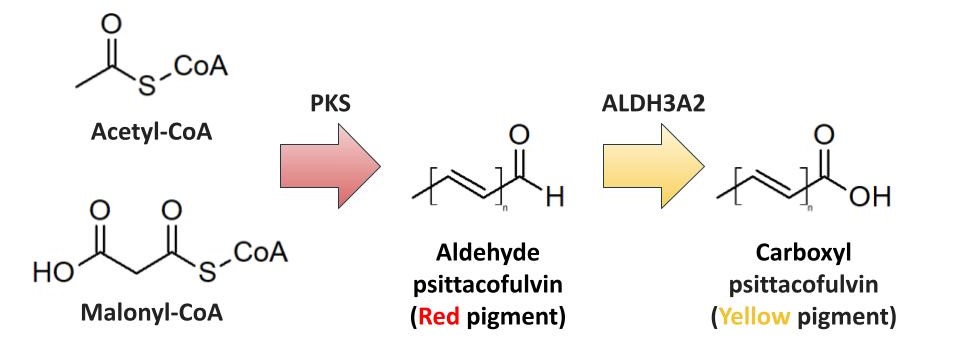Psittacofulvin is a unique pigment in parrots
Parrots have a unique pigment called psittacofulvin, which produces the vibrant colors of red, orange, and yellow feathers. Unlike many other birds that obtain their feather colors from carotenoids found in their diet, parrots synthesize psittacofulvin within their bodies. This self-synthesis is what gives parrots their distinct, vivid colors compared to other bird species.
Psittacofulvin synthesis
The synthesis of psittacofulvin starts with an enzyme called polyketide synthase (PKS), which forms the base structure and produces red psittacofulvin molecules. The enzyme ALDH3A2 then oxidizes these red molecules, transforming them into yellow psittacofulvin. If ALDH3A2 is highly active, more yellow pigment is produced; if its activity is low, the red color remains more pronounced. In this way, the amount of ALDH3A2 influences feather color variation, playing a key role in creating the diverse colors in parrot feathers.
The combination of PKS-based pigment production and ALDH3A2-driven color adjustment produces the rich feather colors seen in parrots.

The color mechanism of psittacofulvin
1. PKS variants and color differences
In wild budgerigars, yellow psittacofulvin interacts with the feather’s structural coloration to appear green. This green or yellow coloration is typical in wild budgerigars with high psittacofulvin levels. However, selective breeding has led to white or blue budgerigars. These colors result from mutations in the PKS gene, which stop psittacofulvin synthesis. Without this pigment, feathers appear white, and structural coloration can create a blue appearance.
In essence, if PKS functions normally, budgerigars will have green or yellow feathers. When PKS is inactive, the birds have white or blue feathers.
2. ALDH3A2 expression and feather color
The color of psittacofulvin synthesized by PKS depends on the level of ALDH3A2 expression:
– Red feathers: Low ALDH3A2 expression
– Yellow feathers: High ALDH3A2 expression
A specific genetic mutation (SNP) near the ALDH3A2 gene controls this enzyme’s expression level. Birds with this mutation show high ALDH3A2 expression, leading to yellow feathers, while those without it have low expression, resulting in red feathers.
References
Price-Waldman R, et al. Avian Coloration Genetics: Recent Advances and Emerging Questions. J Hered. 2021 Aug 25;112(5):395-416.
TF Cooke, et al. Genetic Mapping and Biochemical Basis of Yellow Feather Pigmentation in Budgerigars. Cell. 2017 Oct 5;171(2):427-439.e21.
R Arbore, et al. A molecular mechanism for bright color variation in parrots. Science. 2024 Nov;386(6721):eadp7710.
